Knitted blanket

It is very difficult to imagine a modern inhabitant indifferent to multifunctional objects. Such things constantly attract attention, they want to be acquired or created without the help of others. Take, for example, a blanket: due to the close attention of designers, this thing is considered both a fashionable highlight of the room and a multifunctional solution.
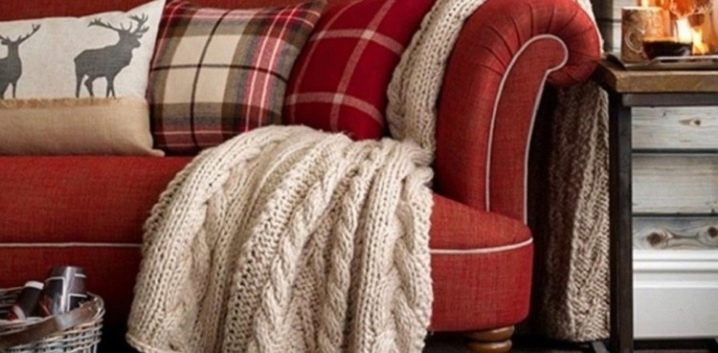
Features and Benefits
Knitted plaid models are truly unique varieties of bedspreads. The main difference from ordinary blankets is the production method - they are represented by a knitted fabric. Basically, the models under consideration are produced from a hypoallergenic composition that does not cause skin irritation. This nuance is especially important for allergy sufferers and people with more sensitive skin prone to inflammation from minimal contact with the yarn.
In the process of creating the product, soft, cozy and comfortable threads are used, which are completely devoid of thorny components.
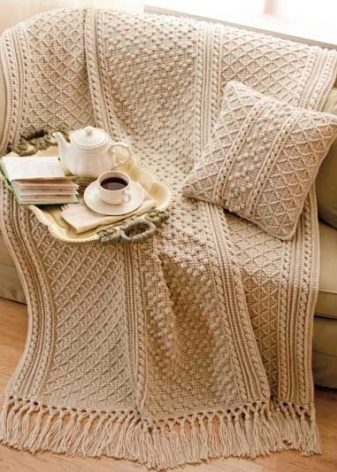
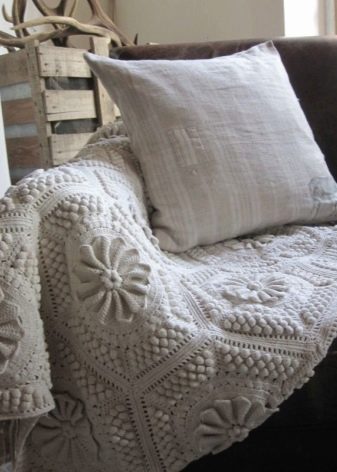
Knitted plaid models are not only amazing capes. They are truly versatile and have many functions.
In addition to the decorative component and the ability to add new colors to the already familiar and monotonous design of your room:
- will bring completeness and add neatness to the overall look of the bedroom (both a large bed and a small sofa);
- turn into a temporary cover for any of your furniture set;
- can be used as an air blanket (which is especially in demand in the summer and off-season);
- products for babies are perfectly transformed into convenient and multifunctional envelopes, comfortable for frequent walks or a trip to the children's clinic;
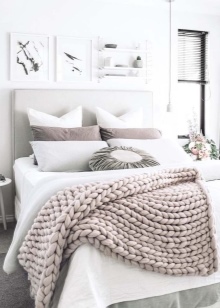
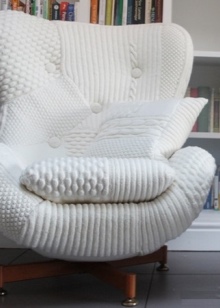
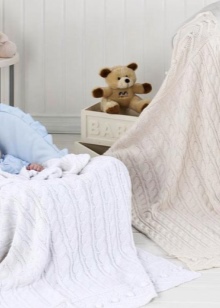
- depending on the available volume of material and the breadth of imagination, the canvases will turn into an amazing warm and cozy rug, which ideally fits over the mattress of a crib or on the floor on top of the carpet (in order to maintain the warmth and hygiene of the child for a long time);
- such models perfectly cope with the function of a warm sweater or overalls, so carefully and at home enveloping their owner, who is sitting down to watch TV (this is especially true in a cold room);
- depending on the quality of the composition, knitted blankets are endowed with healing benefits (such properties apply to models made of sheep or camel wool);
- will create a truly comfortable environment in your apartment or house.
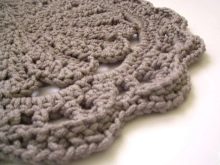
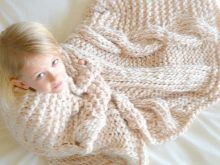
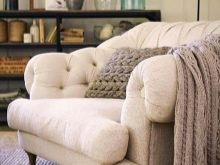
Unfortunately, even the best options for a blanket made of woolen fabric are not suitable for everyone: despite the superiority of the composition and the amazing quality of this material, a certain proportion of buyers are forced to face its intolerance.
In addition to an impressive number of advantages, knitted plaid models are endowed with a number of disadvantages:
- in most cases, it is impossible to put them on the existing mattress in order to vary the level of softness to the desired one (as a result of pressure on the embossed knitting, "prints" of the pattern will be fixed on the body, and this is harmful for proper blood flow);
- knitted models require impressive amounts of yarn and a huge amount of time to create;
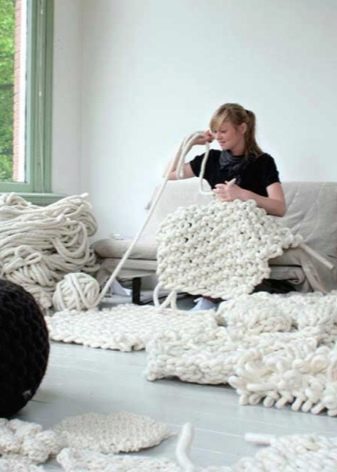
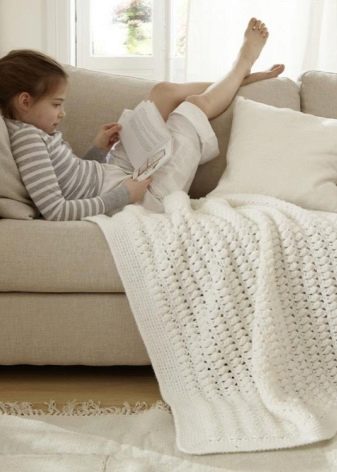
- almost always a problem is the care of such blankets, and they are also very unstable to the washing process in the machine (they require washing by hand, delicate spinning and drying away from sunlight);
- the drying process at the end of the wash takes much longer than that of their textile counterparts, since a sufficiently spacious vertical surface is required (with the standard drying option, they stretch, which explains the deformation of the pattern and the reduction in the width of the existing fabric);
- are subject to frequent accumulation of dust particles, which creates a favorable habitat for dust mites (this explains the appearance of allergic reactions).
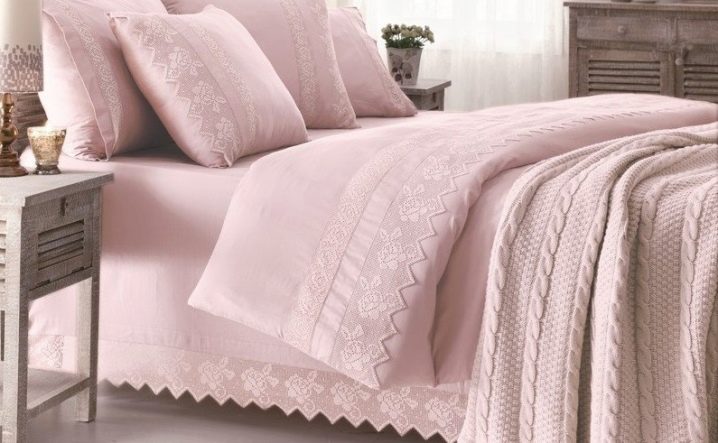
Varieties
Models of knitted blankets are presented in a variety of shapes (blankets with a hood or with a hare and ears, stripes, as well as buttons for transformation, for winter with lining, from stripes bound, personalized with lining, rectangular, textured, etc.).
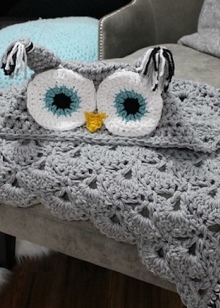
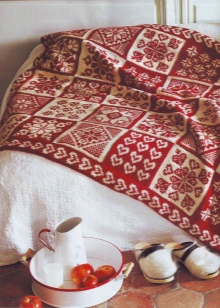
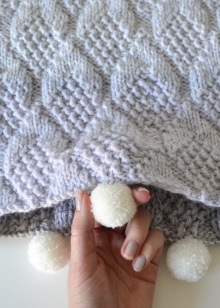
Depending on the production method, this product is made:
- hand-knitted with knitting needles or crocheted;
- by machine using a knitting machine or using special equipment.
The differences between the types of execution are obvious: the machine version often requires actions using a thinner yarn, a huge number of different loops, a variety of patterns and variations of weaves. This product is created much faster in contrast to the analogue, which is made manually.
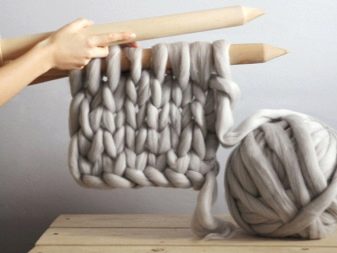
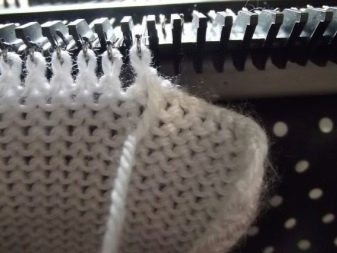
A product created on production equipment is always distinguished by accuracy of execution and uniformity of design. Thanks to a well-oiled mechanism, you can knit any degree of complexity and desired future pattern.
The manual knitting mechanism is unique in appearance: until the end of the knitting process of the blanket, the level of density of the created loops may vary. It is far from always as perfect as with the machine method of execution, however, after washing, the fabric generally looks more even.
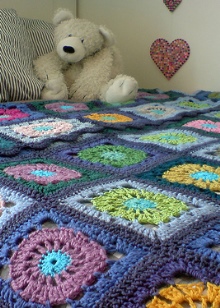
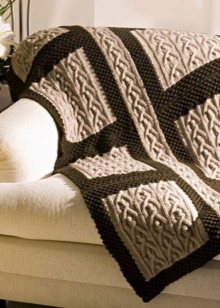
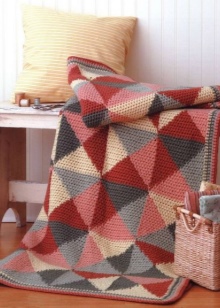
Manual work is not limited to any technologies, thus, it allows you to realize absolutely any idea of the creator, it is beneficial to show directly the texture itself and the desired pattern in the best possible light.
Materials (edit)
The yarn for making blankets is diverse, however, shiny metallized threads are practically not used: they darken the overall texture of the product and prick the body. Often, for the execution of such a blanket, craftsmen use the remnants of the existing yarn, embodying bright colors. In other embodiments, thick yarn is generally purchased for hand-making the product. It allows you to create an original blanket in a short period of time.
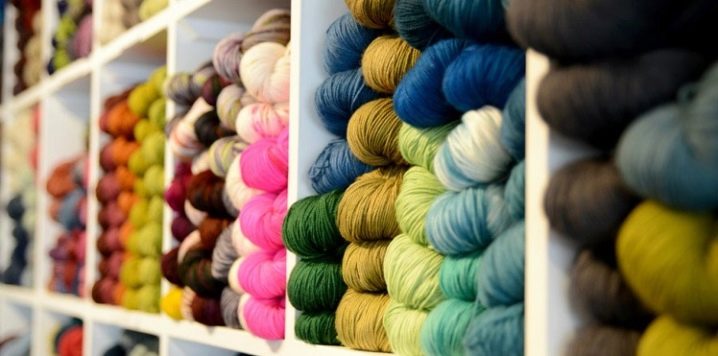
The more popular materials used for the models under consideration are cotton or acrylic, wool, or semi-wool, a composition of grass, as well as a mixture of angora and acrylic, mohair, or wool with acrylic. Any of the presented types of raw materials is distinguished by its own characteristics and advantages. For example, products made from grass and knitted with knitting needles are unrivaled in softness, volume and body comfort.
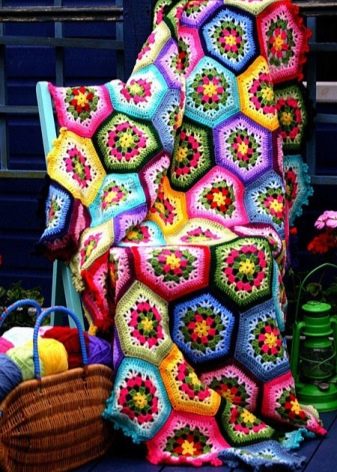
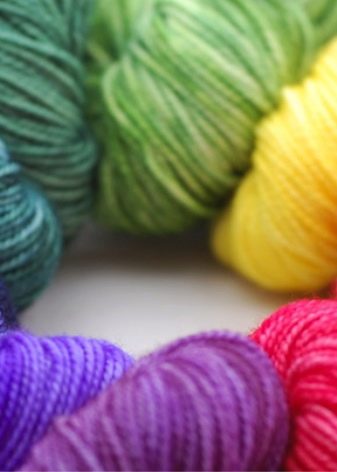
Blankets made of wool or semi-wool, improved with a textile base, are a real competitor to the usual blankets made of fabric. The cotton options are very lightweight, non-irritating and easy to clean.
Dimensions (edit)
The required dimensions of the future product depend on the shape of the bed. In each case, they are individual. For kids, this indicator can be presented as 70x70 cm and 80x100 cm, and 100x100 cm, 70x125 cm or 110x140 cm.
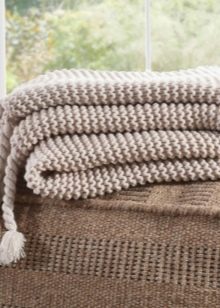
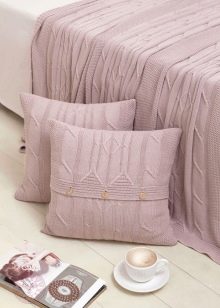
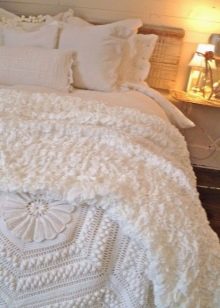
Since this bed accessory must cover both the bed and its owner, the size of the blanket must be equal to the growth of the owner with an additional margin. The dimensional indicators of the product under consideration for adults are also diverse: 130x170 cm, 140x180 cm, 150x180 cm, 150x200 cm, 160x200 cm, 160x220 cm, 180x200 cm, 250x260 cm, 240x220 cm.
It is worth remembering that very large sizes of bedspreads are the least comfortable, especially when made by hand.
Therefore, thinking about purchasing or making a blanket with your own efforts and without the help of others, you need to be aware of exactly what function such a product will implement.
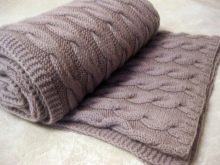


Colors
The palette of shades of knitted products impresses with its variety. Manufacturers provide a mass of varieties of shades that will definitely satisfy even the most demanding preferences. The often offered color lines combine black and other practical colors: deep gray, sky blue, mustard, light brick, red, bright brown, burgundy. The light palette contains traditional colors: white and soft beige, as well as warm pastel colors (delicate pink and lilac, bright green and mint, rich lemon).
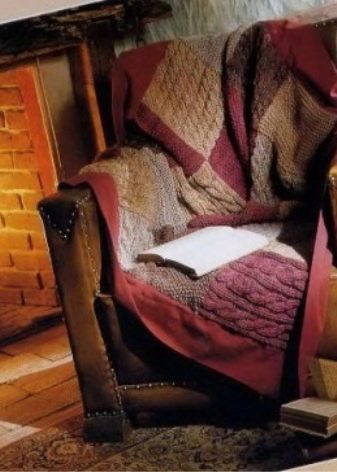
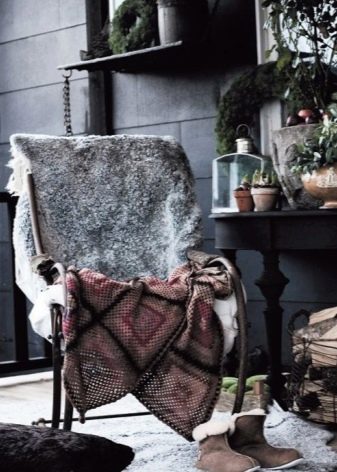
Knitted products for frequent use in everyday life are mainly made in practical and juicy shades. The leaders of the color palette among the masters are the following: rich green, terracotta, bright orange, soft coral, noble crimson, pale mottled (multi-colored or two-tone). Knitted fabric models for babies stand out for their bright cheerfulness.

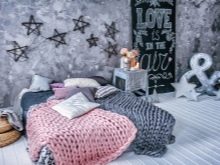

Such colorful options for bedspreads are worthy of special attention, they are completely devoid of boundaries in the selection of the desired color.
Patterns and types of knitting
The options for the knitted plaid pattern are varied. In production, these products are made by machine using conventional knitting.
Manual execution at home is divided into four ways:
- knitting in a single straight line with a smooth transition to the second and next row;
- along a circular path with the addition of a loop in the corners with each future row;
- diagonally connected (oblique version);
- adding individual components (squares).
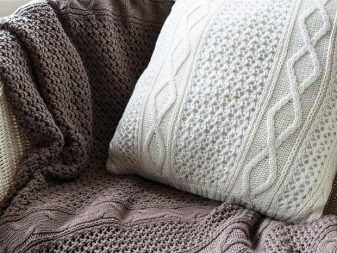

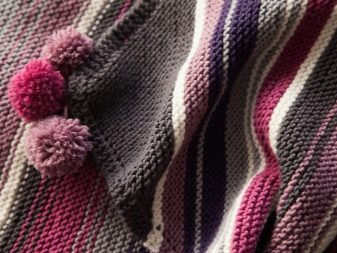
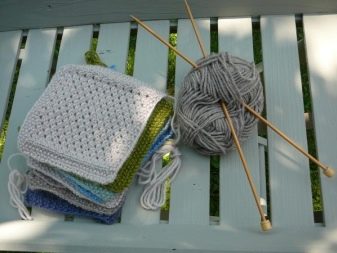
Any technique, of course, is individual, but before creating a model, the degree of density (for precise control of the resulting loops) and the future design are always taken into account.
In appearance, the following plaid options are distinguished:
- large or small knitting relief;
- with or without the addition of a volumetric ornament;
- using various patterns made using a variety of color palette of threads.


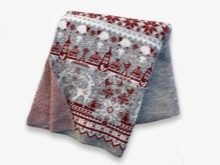
One of the most interesting techniques for making a knitted model at home is assembling a product from old cardigans and sweaters. In this situation, small-sized patches cut into squares are involved.
If we consider patterns, then they are very diverse: from ordinary garter knitting, openwork and to non-standard compositions. The most popular types of decorations for such knitted bedspreads are various braids, plaits, frequent weaves, various combinations of stripes with daisies, as well as using alternating front and back loops.

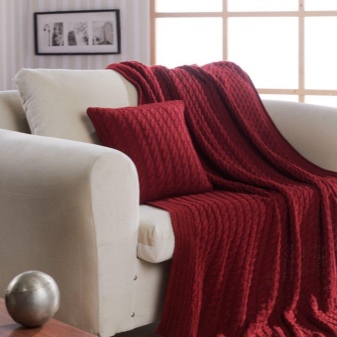
A truly interesting plaid design can be embodied:
- the Tunisian way of knitting - "Afghan" technology with the help of a crochet, when the pattern is created on the basis of two levels;
- the Bavarian knitting technique - the implementation of crocheting along a circular path with the addition of bright components or a canvas in the form of a single square;
- Scandinavian motif - making jacquard ornaments of garter stitch in two colors in the Norwegian style using knitting needles;
- double-sided knitting - at the same time using two threads on the needles or one thread using a crochet.
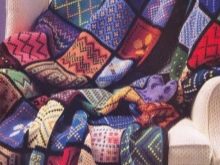

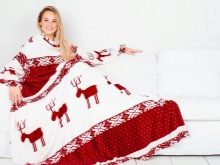
Types of decor and styles
The uniqueness of knitted blanket models lies in the fact that these bedspreads will perfectly fit and decorate the style of any room: from timeless classics and strict minimalism to rich glamor and unsurpassed Empire style. Usually, the main idea is directly dependent on the pattern (embroidery with hearts, 3D-ornament, print with a bear) or colors.A more organically knitted product will look in country style or Provence, avant-garde, or art nouveau, African and patchwork, as well as baroque, boho, or loft, art deco and Arabic style.
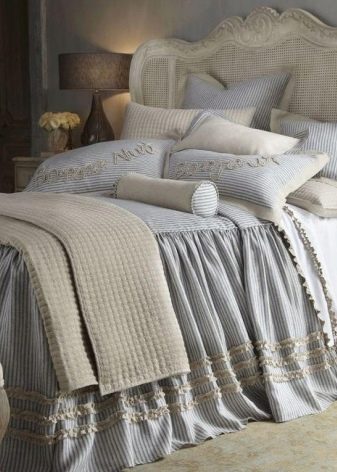

Selection Tips
When purchasing beautiful knitted plaid patterns in a shopping center or other place, you need to pay attention to the following points:
- provision of a quality certificate, as well as compliance with generally recognized hygiene rules;
- all the necessary data on the composition of the materials used, the manufacturer with a reflection of the legal address, as well as the necessary instructions for the implementation of correct operation must be present;
- fixing the indicator of the heat level of this product;
- the presence of positive comments and reviews, useful feedback about this manufacturer, as well as the availability of a guarantee from the seller;
- ratio of price and quality, available properties (you can preview analogues and compare prices).
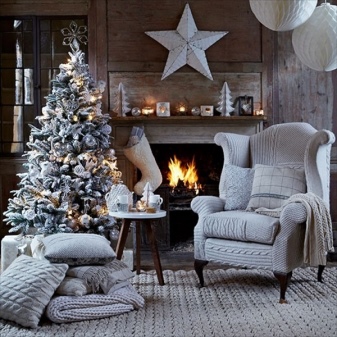
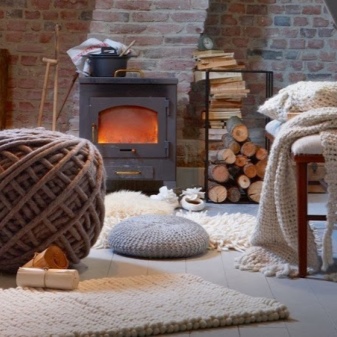
Some helpful tips:
- beautiful models for the winter period (blankets made of woolen fabric) should have a textile lining, as it will definitely retain heat, and the fabric base will preserve the knitted fabric in its original form;
- a handmade blanket in an openwork style is the least practical than a 3D analogue of a narrow embossed knit. A product made of constituent fragments has a less strong plexus, therefore, in the future it will require an extremely careful attitude;
- an accessory with a volumetric, embossed pattern knits much faster, although it seems the most airy. Therefore, it does not retain heat so well and is impractical for frequent use as a blanket;
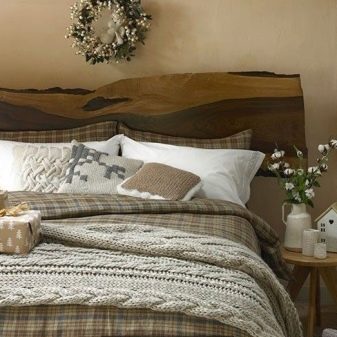
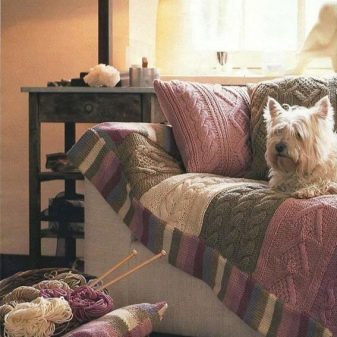
- woolen models give a dry heat effect. Therefore, if a healing result is needed, then a knitted blanket is the best choice (antimicrobial and anti-inflammatory effect, prevention of various colds);
- such a thing as a blanket should be multifunctional, made from high quality yarn and not contain dangerous dyes.
How to care?
Caring for a knitted plaid model is a special topic. Faithful and careful use will give the opportunity to extend the period of operation of a fashionable product, while maintaining the attractiveness of the external appearance and characteristics of a beautiful texture (smoothness, warmth, size, relief). Since the knitted version of the product is subject to the effects of any wash, the following nuances must be taken into account:
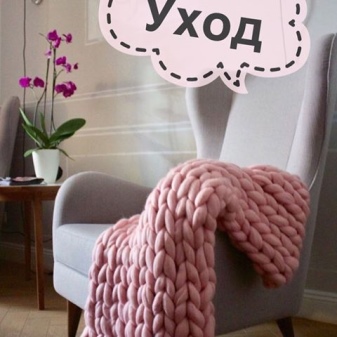
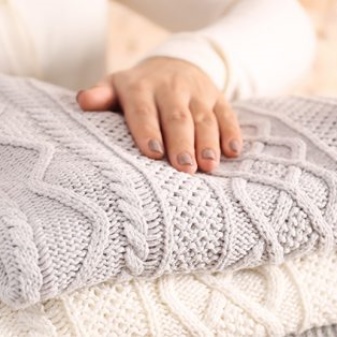
- hand wash is recommended in the absence of special efforts, twisting with the use of a special powder (selected individually for a certain type of yarn);
- lack of boiling, as well as hot water. High water temperature contributes to the reduction of the distance between the fibers and the compaction of the yarn (this is especially true for woolen and semi-woolen yarns with a hollow texture);
- at the end of washing, it is necessary to rinse the product twice in order to wash out the remains of the detergent powder. All this is necessary in order to exclude the appearance of stiffness and loss of the original shade as a result of poor rinsing, and also to prevent the acquisition of a yellow tint;
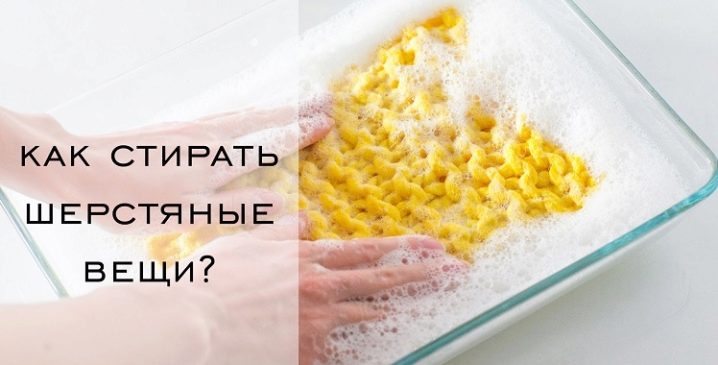
- drying must be natural in the absence of any additional heating devices (hair dryer, battery, iron);
- you can not use a dry brush for cleaning: it will easily pull out the existing loops and add lint, promote the formation of pellets and give an overall "shaggy";
- it is forbidden to knock out the knitted model of the cape or shake it to get rid of dust (as a result of such actions, deformation of both individual loops and the entire volume of the canvas occurs);
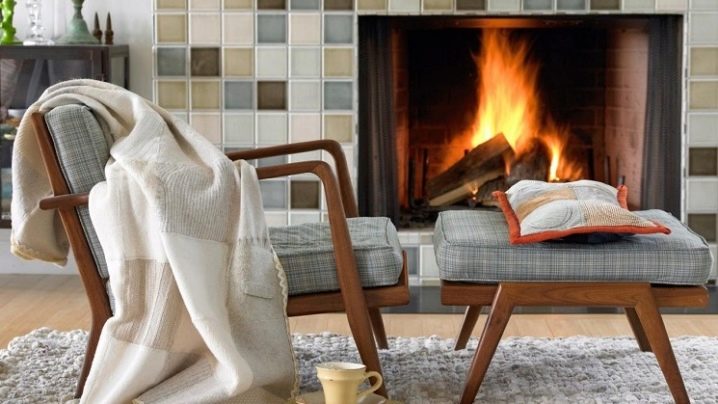
- at times it is necessary to ventilate the product in the fresh air (a balcony or terrace would be an excellent replacement): this will increase the resistance to caking, eliminate the appearance of an undesirable aroma;
- the product label usually contains all the necessary care information.Some manufacturers allow machine washing, while others strongly recommend going to dry cleaning for heavy dirt.
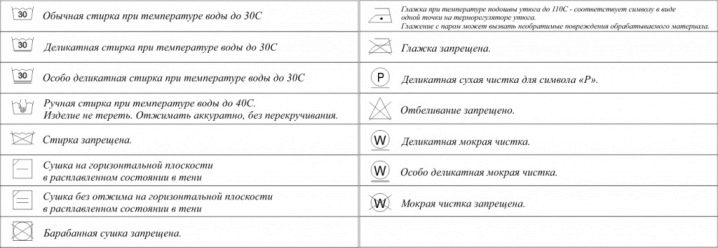
Knitted blankets in the interior
Nowadays, the knitted plaid pattern is a modern and elegant bonus for any room. Now these capes are considered a fashionable accessory for an upholstered sofa or armchair. Such decorations of upholstered furniture not only completely complement the interior design, but also advantageously focus on the implementation of the main idea, adding zest to the interior.
A large-knit embossed style bedspread can be used to decorate a bed in a bedroom. It will very harmoniously dissolve in the overall design of the room, if you keep the idea of a knitted product through the use of decorated pillows. The rich shade of the carpet, the sophisticated shape of the bedside lamp shade, and the stylish ornament of the sofa cushions will enliven any design.
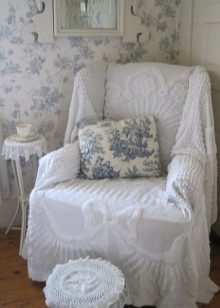

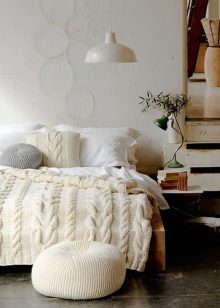
The desire to repeat the idea of a knitted product can be diversified: a blanket of a warm light shade with voluminous braids looks very good and is combined with pillows of a similar design and a pouf, but in the absence of any patterns.
The chosen color of the knitted fabric will provide an opportunity to create the illusion of a set, and a small pillow, repeating the design of the mini-pouf, will add variety to the color palette of the room, preventing an abundance of catchy spots.
A knitted plaid model with wide bright, contrasting stripes looks really unusual. This model is perfect for decorating a light-colored sofa.
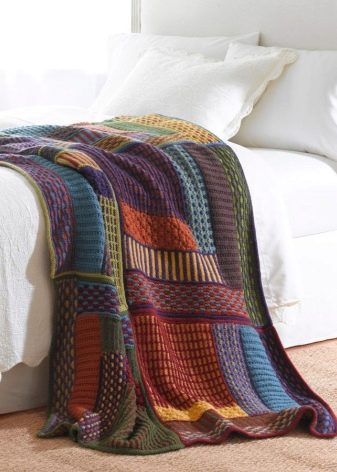
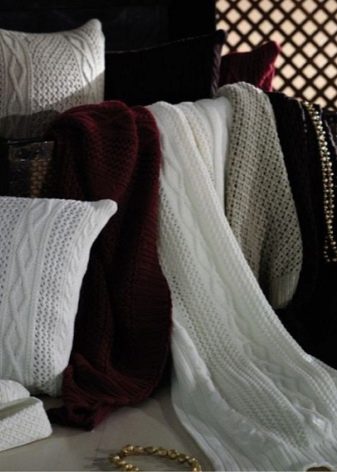
Such a blanket will become not only a fashionable highlight of the interior, but also a practical and functional cape: by collecting a rainbow of light and dark shades, you can significantly extend the life of both the sofa and the blanket itself. It is absolutely not difficult to make a harmonious interior: it is enough to place several pots for flowers similar to color stripes. If they are not there, you can use pictures, fresh flowers, as well as just an ordinary tray, kept in a similar color scheme.
In this video you will see an additional selection of knitted blankets and ideas for creativity.













Thanks for the useful information!
Thanks for the helpful article!
The comment was sent successfully.